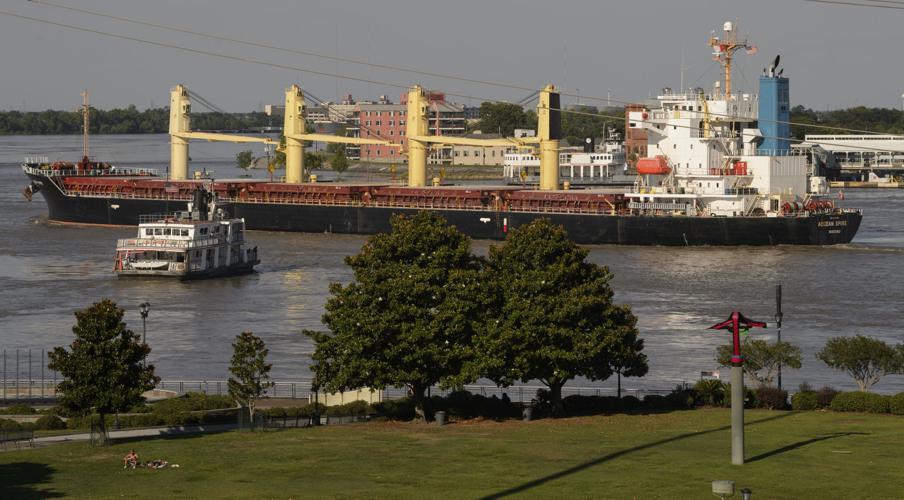The Mississippi River’s record high-water season, which is stretching into its seventh month, is wreaking havoc on commerce and river traffic up and down the waterway’s 2,300-plus miles.
The historic flooding has not only inundated millions of acres of agricultural land — including Louisiana farmland — and caused widespread damage to levees, dams, bridges and roads. It has also put enormous strains on the commercial river traffic that is a lifeblood of American industry.
"It's like being in an airport during severe weather when you're trying to get out," said Rich Teubner, vice president of Seacor AMH, which operates three dozen tow vessels that shuttle barges up and down the river. "It slows everything right down, and everyone is stalled in the queues waiting to get through."
While the strain on river commerce has yet to affect the broader economy, it is near the breaking point. River pilots are working around the clock. The Coast Guard is playing traffic cop and parking ships for days. And river operators are required to use more boats to move the same amount of goods.
“It’s a ripple effect,” explained Teubner. “If a ship doesn’t come in and offload those containers that we pick up at the port, then we’re stalled there. In addition, it is taking a lot more time to get through the locks, and the restrictions (imposed by the Coast Guard) mean there is only one-way traffic in many parts of the river.”
The higher and faster river has indeed slowed incoming seaborne cargo traffic and caused congestion at the mouth of the Mississippi, said Paul Aucoin, president of the Port of South Louisiana. It costs businesses about $25,000 a day to have a cargo ship at anchor, and at one point last week there were 27 ships parked in a queue at the mouth of the river.
“That’s ridiculous,” Aucoin said. “Normally, there are three or four or five ships.”
The Port of South Louisiana is the busiest port in the country, moving more than 300 million short tons of cargo a year, including most of the nation’s agricultural products destined for export. River vessel operators say the Coast Guard has been working closely with industry to try to minimize disruption to this key hub, but it has been an enormous challenge.
Merritt Lane, CEO of Canal Barge, which has a fleet of more than 40 towboats and 800 barges, said the heavy rains that began last November have been compounded by an unprecedented series of events, including record shoaling (or silt build-up) on the Tennessee-Tombigbee Waterway connecting Mobile, Alabama, to the Tennessee River.
“Put all that together and for a company like ours, operating all over the (river) system, we’ve had disruption lasting almost all year long now,” said Lane.
The higher the river, the fewer barges the Coast Guard allows per towboat. The Coast Guard also typically doesn't allow night traffic and stalls boats at choke points like Wilkinson Point at Baton Rouge.
For operators, the restrictions translate directly into additional costs. Both Seacor AMH and Canal Barge reckon that it costs them about 30 percent more to move the same volume of goods under current conditions.
“These delays come out of our pocket,” said Lane.
The latest surge of flooding last month was caused by a large storm in the upper Midwest, resulting in the second-wettest month in the nation’s history, which in turn intensified the snowmelt running in the river system.
The flooding is expected to last through this month at least, so it is too early to estimate what the ultimate cost will be, but the New York-based Insurance Information Institute said that damages already had exceeded $3 billion in May.
Most of the damage has been suffered by upper Midwest states, but Louisiana has not been spared. The Bonnet Carre Spillway has been opened twice this year for the first time in its 88-year history, diverting trillions of gallons of freshwater into the Mississippi Sound and expanding the “dead zone” to record dimensions, wiping out shellfish and other aquatic life in the spill zone.
The state has also been preparing in the event it needs to open the Morganza Spillway, which would divert Mississippi River water into the Atchafalaya River basin. If that happens, it would threaten about 25,000 acres of farmland and crawfish harvests.
And the river conditions are likely to get worse before they get better. Baton Rouge has already shattered a record that had stood since 1927 for the number of days the Mississippi has remained at flood stage. The river had been above the 35-foot flood level for 156 days as of last Monday, when it measured just over 43 feet. It is currently forecast to peak above 44 feet in mid-June.
Though it hasn’t reached that point yet, the worry is that the strain being put on river traffic will eventually become severe enough to start hitting distributors and manufacturers that depend on the river supply to keep their businesses humming.
Seacor’s customers, for example, have not yet seen their feedstock of plastic precursor material dwindle to levels that would threaten their production because they maintain extra inventory. But if those inventories keep falling, they will eventually have to scramble to arrange alternative delivery, by rail or road.
The Coast Guard also prioritizes passenger vessels, so cruise ships have been kept on schedule at the expense of cargo vessels, according to Port of New Orleans spokesman Matt Gresham.
The operators are hopeful that the flood conditions will soon be on the wane, but the trend is worrying.
“I’ve been in this business for 30 years and people have worried about high water and even low water conditions before,” said Lane. “But it is very noteworthy that we’ve been dealing with more extreme weather conditions in the last 10 years than we had in the previous 20.”
Advocate business writer Timothy Boone contributed to this article.











